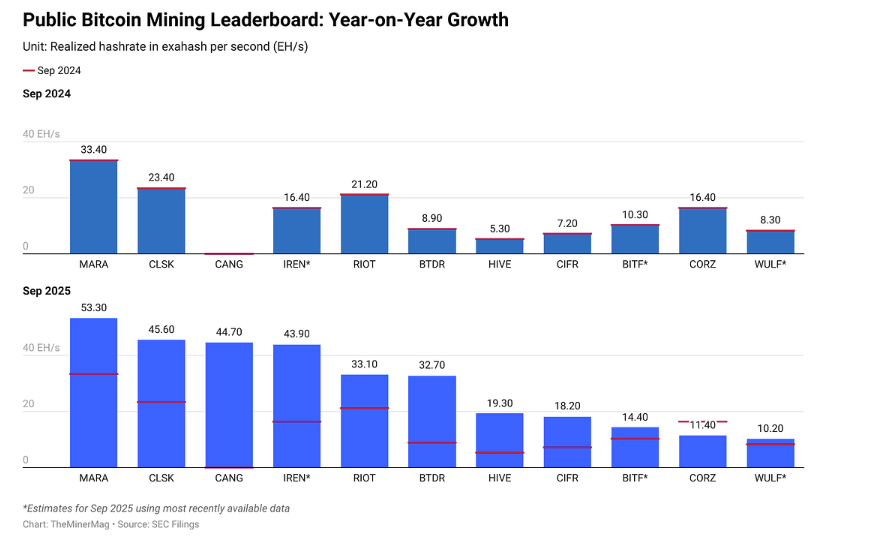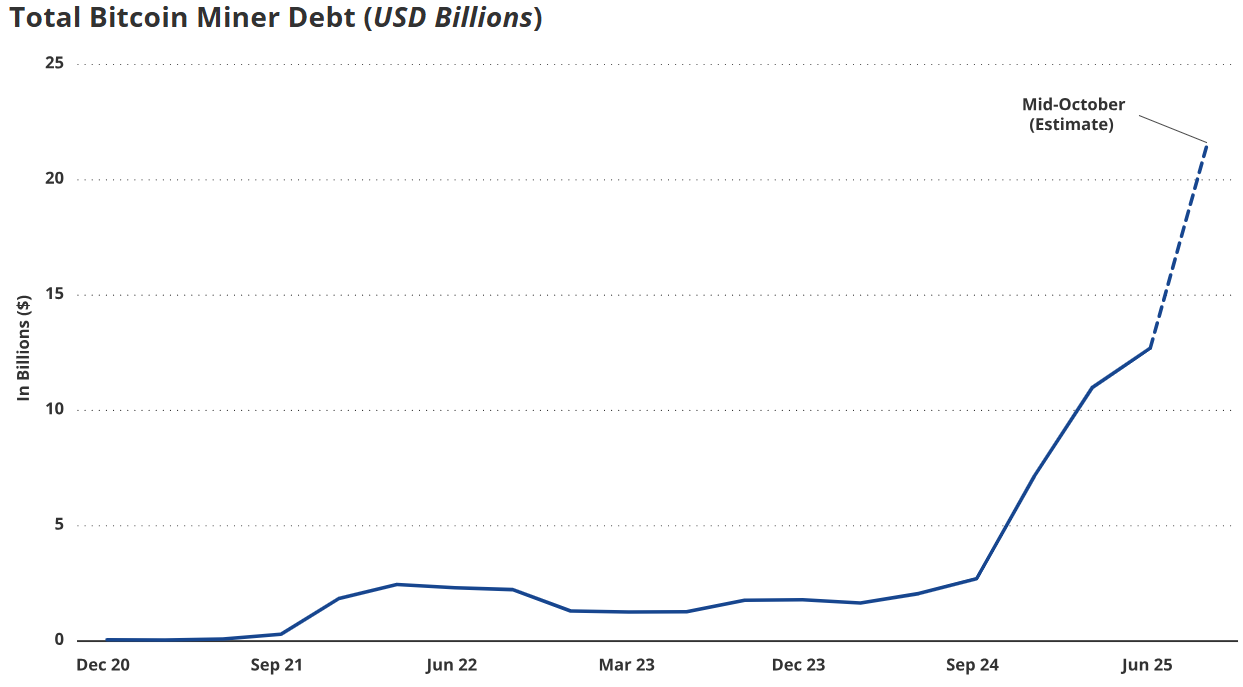Smaller Bitcoin miners have surged in realized hashrate post-2024 halving, closing the gap with industry leaders and intensifying competition. Tier-2 operators like Cipher Mining and Bitdeer have expanded rapidly, contributing to a total of 326 EH/s among top public miners, reshaping the sector’s dynamics.
-
Tier-2 miners narrow gap: Companies such as Cipher Mining, Bitdeer, and HIVE Digital have boosted realized hashrate significantly year-over-year.
-
Post-halving competition heats up as infrastructure investments pay off for mid-tier players.
-
Top miners now hold 326 EH/s, nearly one-third of Bitcoin’s network hashrate, up over 100% from last year according to The Miner Mag data.
Discover how smaller Bitcoin miners are surging in hashrate and debt amid fierce post-halving competition. Explore industry shifts, key metrics, and implications for the future of crypto mining. Stay informed on Bitcoin’s evolving landscape today.
What is driving the surge in Bitcoin miners’ hashrate after the 2024 halving?
Bitcoin miners’ hashrate surge is primarily fueled by aggressive infrastructure expansions and strategic investments by tier-2 operators, closing the competitive gap with established giants. Following the 2024 halving that cut block rewards to 3.125 BTC, mid-sized firms like Cipher Mining, Bitdeer, and HIVE Digital have scaled operations rapidly, achieving substantial year-over-year growth in realized hashrate. This shift indicates a more balanced industry, with collective efforts pushing top public miners to 326 exahashes per second (EH/s) in September, doubling from the previous year.
The Bitcoin mining landscape has transformed significantly since the halving event, which reduced mining rewards and pressured operators to optimize efficiency. Realized hashrate, a critical measure of actual on-chain performance, reflects not just computational power but operational success in mining valid blocks. Publicly traded miners, in particular, rely on this metric to signal efficiency and revenue potential, especially as third-quarter earnings approach. The Miner Mag’s latest Miner Weekly newsletter highlights how these developments are democratizing the sector, allowing smaller players to challenge the dominance of leaders like MARA Holdings, CleanSpark, and Canaan.

Hashrate, at its core, quantifies the total computational effort dedicated to securing the Bitcoin blockchain through proof-of-work consensus. Realized hashrate goes further by focusing on effective output, making it a vital indicator for investors assessing a miner’s true productivity. As competition intensifies, companies are not only upgrading hardware but also optimizing energy use and site locations to maximize this metric. For instance, while top-tier firms maintain their lead, the rapid ascent of others underscores the halving’s role in forcing innovation across the board.
Industry experts emphasize that this surge is no accident. “The post-halving environment has accelerated the maturation of mid-tier miners, who leveraged years of preparation to capture more market share,” noted analysts from The Miner Mag. This evolution benefits the broader Bitcoin network by distributing hashrate more evenly, potentially enhancing security and resilience against centralized threats.
How is debt playing a role in the Bitcoin mining hashrate competition?
The Bitcoin mining hashrate competition has led to a dramatic increase in sector-wide debt, reaching $12.7 billion as of recent reports, up from $2.1 billion a year prior, according to VanEck research. Miners are borrowing heavily to fund expansions into advanced mining rigs and diversified ventures like artificial intelligence infrastructure, essential for staying competitive in a post-halving world where margins are thinner.
To maintain or grow their share of Bitcoin’s total hashrate, operators must invest continuously in next-generation application-specific integrated circuits (ASICs), which offer higher efficiency but come at a premium cost. VanEck’s analysis points out that without such upgrades, firms risk obsolescence as peers pull ahead. Short sentences highlight the urgency: Debt fuels growth. Growth sustains hashrate. Hashrate drives revenue.
Supporting data from VanEck reveals that this debt surge correlates directly with hashrate expansions, with many companies pivoting to high-performance computing (HPC) for AI to generate additional income streams. For example, HIVE Digital has invested in HPC expansions to offset halving impacts, blending mining with emerging tech demands. Expert insights reinforce this trend: “Strategic debt is a tool for survival in mining’s capital-intensive arena,” as observed by VanEck researchers, allowing firms to navigate reduced block rewards while positioning for long-term viability.

Statistics underscore the scale: Public miners’ collective hashrate now approaches one-third of the Bitcoin network’s total, a testament to these financial maneuvers. However, this approach carries risks, including interest burdens and market volatility, prompting calls for balanced strategies that prioritize sustainable growth over aggressive leverage.
Frequently Asked Questions
What are the biggest challenges for smaller Bitcoin miners post-halving?
Smaller Bitcoin miners face intensified competition and reduced rewards after the 2024 halving, which slashed block subsidies to 3.125 BTC. They must invest in efficient hardware and manage rising energy costs to boost hashrate, while diversifying into AI helps mitigate financial pressures from thinner margins.
How does realized hashrate differ from total hashrate in Bitcoin mining?
Realized hashrate measures the actual on-chain block mining performance of Bitcoin miners, focusing on valid outputs rather than raw computational power. It’s a more accurate gauge of efficiency and revenue for operators, especially public companies tracking operational success during earnings seasons.
Key Takeaways
- Hashrate Surge Among Tier-2 Miners: Firms like Cipher Mining and Bitdeer have significantly increased realized hashrate, narrowing the gap with leaders and reaching 326 EH/s collectively for top publics.
- Debt as a Growth Driver: Sector debt hit $12.7 billion, enabling expansions into mining rigs and AI, though it heightens financial risks in a competitive environment.
- Post-Halving Adaptation: Diversification into HPC and efficiency upgrades are key for miners to sustain hashrate shares and secure the Bitcoin network long-term.
Conclusion
The Bitcoin miners’ hashrate surge and escalating debt levels post-2024 halving signal a maturing industry where competition fosters innovation and balance. Tier-2 operators’ rapid growth, backed by strategic investments, not only challenges established players but also strengthens the overall Bitcoin network. As miners continue to adapt through diversification and efficiency gains, the sector’s resilience will likely improve, offering opportunities for investors and participants alike—keep watching for further developments in this dynamic space.
